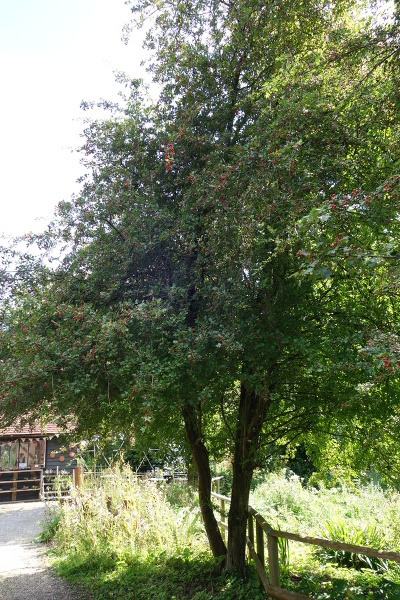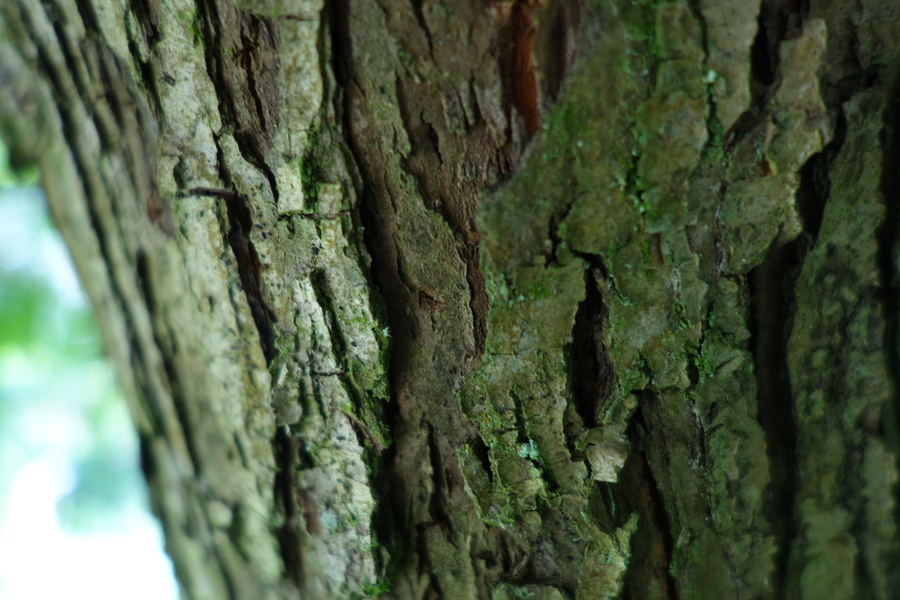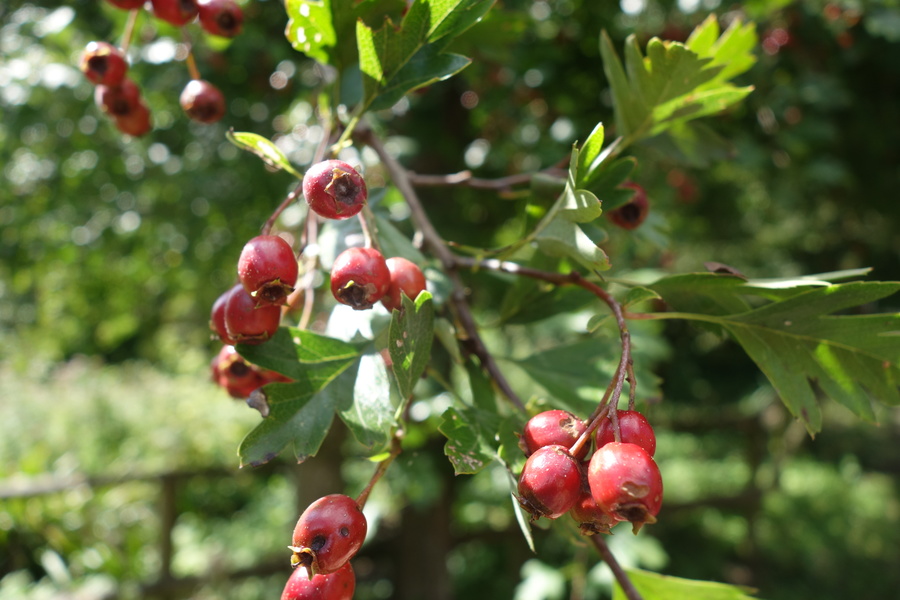HAWTHORN ( Crataegus monogyna )
The hawthorn is a tenacious tree that has been in Britain since before the last ice-age. It grows on a wide variety of land, from open scrub where it is sparsely found, to rich soil where it may form excluding thickets. It is perhaps most often found however, as hedgerow. In Britain the two species monogyna (single flowered) and oxyacantha (thorny) hybridise readily although the latter is found more often in the midlands of Britain, giving it the moniker Midland hawthorn.
The hawthorn is slow growing and can live upto 1000 years. There is a specimen in France with a height of 30ft and a circumference over 8ft.
Hawthorn in the Ogham
Hawthorn’s presence in Magic and lore appears to mirror its physical variety. In some customs, it was regarded as unlucky to cut down, and many trees in Ireland and Scotland were left well alone as a result. This account from a 1792 survey in Monedie, Scotland serves to illustrate the seriousness with which this doctrine was assumed:
There is a quick thorn, of a very antique appearance, for which the people have a superstitious veneration. They have a mortal dread to lop off, or cut any part of it, and affirm, with a religious horror, that some persons, who had the temerity to hurt it, were afterwards severely punished for their sacrilege
– The Statistical Accounts of Scotland, Appendix for Monedie, County of Perth, OSA, Vol. III, 1792
In some localities it was believed that bringing the hawthorn blossom into a house would cause a death, sometimes said to be your own mothers death, in the same year. Yet in other traditions, the May blossoms would be bought happily into the house to be hung over the chimney breast to ward off evil spirits.
The polarity of beliefs is illustrated most clearly by the traditions of the ancient Greeks. The Greeks adored the tree, considering it highly fortuitious omen. Greek wedding altars would be decorated with May blossoms, the bride would wear a hawthorn wreath, and the bridal bed would be lit with hawthorn torches.
In all customs, it seems Hawthorn was strongly associated with lightning and fire, which reflects and interesting physical attribute: Hawthorn burns particularly brightly and with an intense heat. In Ancient myths, it was said that the Hawthorn tree was created by a lightning strike, and subsequent traditions held that hiding under a hawthorn would protect one from lightning in a storm.
A particularly curious set of hawthorns exist in and around Glastonbury in England. It is said that the man that buried Jesus, Joseph of Arimathea, took Jesus’s staff with him to England and thrust it into the ground on Wearyall Hill in Glastonbury (which at the time was on the island of Avalon) whereupon it grew into a hawthorn tree. But not just any hawthorn; a hawthorn that flowered twice a year once in the spring and once at Christmas. The original tree was cut down by puritans during the English Civil War but many cuttings had previously been propagated and to this day bi-flowering hawthorns persist in Glastonbury. Blossom is sent to the Queen every christmas from a cutting propagated in St John’s school in Glastonbury.
May Day
No account of Hawthorn would be complete without a discussion of May Day. May day is celebrated on the 1st May, but it is worth considering that we adopted the Gregorian calendar in 1752, which shifted the dates backwards relative to the seasons by 14 days. This is relevant since Hawthorn, and Hawthorn Blossom (May flowers, may blossoms) feature heavily in the festivities, and so we can se historically that on May Day the tree would be in full bloom as May day would be later than it is now.
May Day marks the arrival of summer, and is celebrated across Europe in at least 14 countries.
Young women on May Day would wash their faces in the dew of May blossoms in the ope of making themselves more attractive. An old rhyme goes:
The fair made who the first of May
Goes to the field at the break of day
And washes in dew from the hawthorn tree
Will ever after handsome be
A typical May Day celebration sees the choosing of a May Queen from the village who is then adorned with hawthorn blossom and a hawthorn blossom crown. She is then paraded around the village for all to see. Few know that there also exists the May King.
In Suffolk there used to be an old tradition that whoever finds the first hawthorn in blossom would be awarded a dish of cream for breakfast.
May day fete’s also feature Morris dancers and other troupes who might make use of a Maypole: a tall post with ribbons attached that dancers rotate around.
Practical uses of Hawthorn
Known as quickthorn, or quickset hedge, Hawthorn to this day is planted as a barrier hedge. When you compare the alternatives: hurdles, or in this century steel-wire topped with barbed-wire, it is hard to beat a Hawthorn hedge. It’s easy to climb over a barbed wire fence, but try scrambling your way through 2m of densely thicketed Hawthorn, and you’ll look like the old saying: like you’ve been dragged through a hedge backwards. Self healing, essentially free of material cost except labour to install, with a replacement interval of a few hundred years, and supporting myriad wildlife species to boot, no wonder Hawthorn is the most frequently mentioned tree in ancient boundary surveys. During the Parliamentary enclosure period alone 200,000 miles of Hawthorn hedge were planted. Nothing artificial comes close!
Culinary uses of Hawthorn
Hawthorn leaves and flowers are a traditional wayfaring snack, so common in the British Isles that they have earned the vernacular “Bread and Cheese”.
Medicinal properties
At least 20 species of hawthorn have been employed traditionally for medicinal purposes. Hawthorn appears in both traditional chinese medicine and European medicine and was traditionally employed for a variety of ails. Whilst it was prescribed for several different stomach complaints, it was most commonly prescribed as a heart tonic.
Modern medicine has demonstrated that hawthorn extracts can in-vitro: improve the efficiency of the heart (are cardiotonic), reduce the likelikehood of heart arrhymias, reduce hypertension, decrease serum levels of cholesterol, and is anxioxidative. Furthermore, clinical trials have demonstrated hawthorn as effective in reducing the likelihood of congestive heart failure, hypertension, angina, and minor arrhythmia. All with no significant adverse effects being reported!
References
- Sinclair, Sir John. The Statistical Account of Scotland, Monedie, Perth, Vol. 3, Edinburgh: William Creech, 1792, p. 610. University of Edinburgh, University of Glasgow. (1999) The Statistical Accounts of Scotland online service: (http://stataccscot.edina.ac.uk/link/osa-vol3-p610-appendix-perth-monedie)
- Chang, Qi, et al. “Hawthorn.” The Journal of Clinical Pharmacology 42.6 (2002): 605-612.


